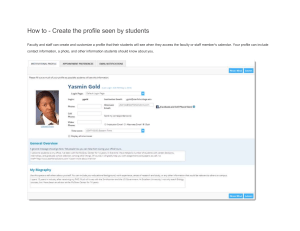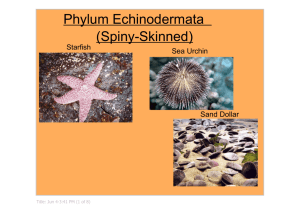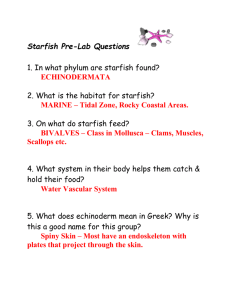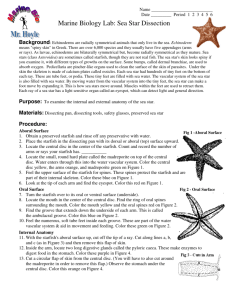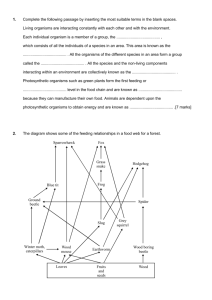Starfish Dissection
advertisement
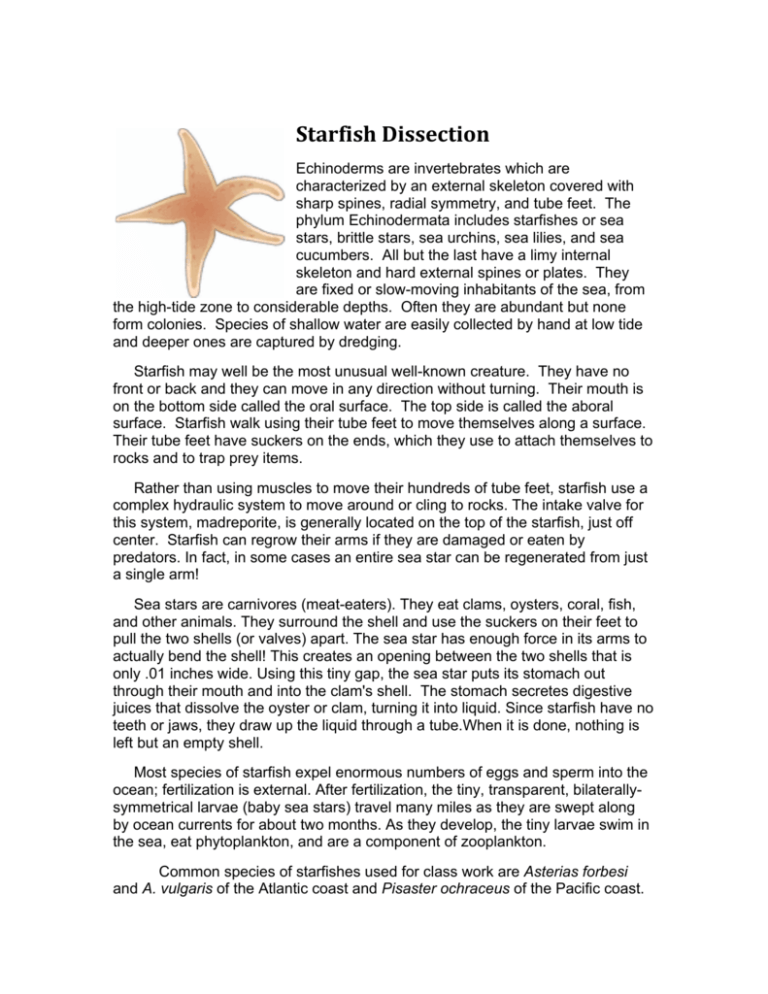
Starfish Dissection Echinoderms are invertebrates which are characterized by an external skeleton covered with sharp spines, radial symmetry, and tube feet. The phylum Echinodermata includes starfishes or sea stars, brittle stars, sea urchins, sea lilies, and sea cucumbers. All but the last have a limy internal skeleton and hard external spines or plates. They are fixed or slow-moving inhabitants of the sea, from the high-tide zone to considerable depths. Often they are abundant but none form colonies. Species of shallow water are easily collected by hand at low tide and deeper ones are captured by dredging. Starfish may well be the most unusual well-known creature. They have no front or back and they can move in any direction without turning. Their mouth is on the bottom side called the oral surface. The top side is called the aboral surface. Starfish walk using their tube feet to move themselves along a surface. Their tube feet have suckers on the ends, which they use to attach themselves to rocks and to trap prey items. Rather than using muscles to move their hundreds of tube feet, starfish use a complex hydraulic system to move around or cling to rocks. The intake valve for this system, madreporite, is generally located on the top of the starfish, just off center. Starfish can regrow their arms if they are damaged or eaten by predators. In fact, in some cases an entire sea star can be regenerated from just a single arm! Sea stars are carnivores (meat-eaters). They eat clams, oysters, coral, fish, and other animals. They surround the shell and use the suckers on their feet to pull the two shells (or valves) apart. The sea star has enough force in its arms to actually bend the shell! This creates an opening between the two shells that is only .01 inches wide. Using this tiny gap, the sea star puts its stomach out through their mouth and into the clam's shell. The stomach secretes digestive juices that dissolve the oyster or clam, turning it into liquid. Since starfish have no teeth or jaws, they draw up the liquid through a tube.When it is done, nothing is left but an empty shell. Most species of starfish expel enormous numbers of eggs and sperm into the ocean; fertilization is external. After fertilization, the tiny, transparent, bilaterallysymmetrical larvae (baby sea stars) travel many miles as they are swept along by ocean currents for about two months. As they develop, the tiny larvae swim in the sea, eat phytoplankton, and are a component of zooplankton. Common species of starfishes used for class work are Asterias forbesi and A. vulgaris of the Atlantic coast and Pisaster ochraceus of the Pacific coast. Objective: To examine the external and internal anatomy of a starfish Starfish Prelab Questions 1. Name the kingdom, phylum and class of the starfish we are dissecting. 2. What is the habitat for starfish? 3. On what do starfish feed? 4. What system in their body helps them catch & hold their food? 5. What does echinoderm mean in Greek? Why is this a good name for this group? 6. Name 2 classes of echinoderms & a member of each class. 7. Where does water enter a starfish? Where does it leave? Materials: Preserved starfish, dissecting pan, scissors, scalpel, forceps, T-pins, pencil, lab apron, safety glasses Procedure (Aboral Surface): 1. Put on your lab coat and safety goggles. 2. Obtain a preserved starfish and rinse off any preservative with water. CAUTION: The preservative used on the starfish can irritate your skin. Avoid touching your eyes while working with preserved starfish. 3. Place the starfish in the dissecting pan with its dorsal or aboral (top) surface upward. Notice that the starfish’s body plan consists of 5 rays radiating out from a central disk. Although most starfish have 5 rays, sun stars have 7 to 14 rays, and some sea stars have 15 to 24 rays. 4. Using the hand lens, examine the skin on the aboral surface. Notice the many coarse spines that cover the entire aboral surface. The epidermis is spiny and irregular b/c parts of the endoskeleton protrude through the skin. Around the base of the spines are pedicellariae, which are jawlike structures. They capture small animals and keep the epidermis free of foreign objects. The skin gills are soft projections from the aboral surface that are lined by tissue of the inner cavity. They provide a large, moist area across which oxygen can be removed from the water. The skin gills are protected by pedicellariae. 5. Referring to Figure 1, use a hand lens to locate a spine and the pedicellariae around it. Locate the skin gills near some pedicellariae. 6. Locate the central disc in the center of the starfish. There is a small red or yellow buttonlike structure called the madreporite on top of the central disc. The madreporite, or sieve plate, contains many tiny pores through which water enters the water vascular system. The water vascular system is a system of water-filled canals and appendages that function primarily in locomotion and feeding. 7. Try to find the anus in the center of the central disc. The anus, which opens out from the intestine, is the opening through which wastes are eliminated from the body. 8. Sketch the aboral surface of the starfish and label the following structures: central disk, rays, spines, madreporite, and anus Procedure (Oral Surface): 9. Turn the starfish over to its ventral or oral surface (underside). 10. Locate the mouth in the center of the central disc. Notice the small spines that surround the mouth. Many types of starfish feed by pushing part of the stomach out through the mouth. The stomach secretes enzymes that digest prey. 11. Find the ambulacral groove that begins at the mouth and extends down the center of each ray. Feel the numerous, soft tube feet inside each groove. These are part of the water vascular system & aid in movement and feeding. Each tube foot is a hollow, thin walled cylinder with a bulb-like structure called the ampulla at one end and sucker at the tip. Fluid pressure changes caused by muscle contractions in the ampulla and tube feet create suction in the tip of the tube foot. The suction enables the starfish to pull itself along a surface or to grasp prey. 12. Locate the eyespots, which are tiny red or pink dots that are found on the oral surface of a small tentacle at the tip of each ray. An eyespot is made up of 80 to 200 ocelli, which contain granules of red pigment. The eyespots are sensitive to light but are not capable of forming images. 13. Sketch the oral surface of the starfish and label the following structures: ray, ambulacral groove, mouth, tube feet, oral spines, and eyespot. Procedure (Internal anatomy): 14. With the starfish's aboral surface facing you, cut off the tip of a ray. Cut along lines a, b, and c (as shown below) and then remove this flap of skin. 15. Inside each arm, locate two long digestive glands called the pyloric caeca. These make enzymes to digest food in the stomach. A short intestine runs from the upper surface of the pyloric stomach to open at an anus in the center of the upper body 14.. Cut a circular flap of skin from the central disc. (You will have to also cut around the madreporite in order to remove this flap.) Observe the stomach under the central disc. 15. Remove the pyloric caeca from the dissected ray. Find the gonads (testes or ovaries) underneath. These may be small if the starfish is NOT in breeding season. Remove these to see the rest of the water vascular system. 16. Cut off the tip of a ray to observe the parts of the tube feet. Find the zipperlike ridge that extends the length of the ray. The tube feet are attached to these. 17. Locate the bulb-like top of a tube foot called the ampulla. This sac works like the top of an eyedropper to create suction. The bottom of the tube foot is a sucker. 18. Running down the center of each arm is a radial canal to which tube feet are attached. 19. In the central disc the five lateral canals connect to a circular canal called the ring canal. Find this canal & label it on figure 5. 20. A short, canal called the stone canal leads from the ring canal to the madreporite where water enters. 21. Dispose of the starfish as instructed and clean your dissecting tray and tools. 22. Wash your hands with soap and water. Post Lab Questions: 1. What type of symmetry did your starfish have? 2. What is the upper surface of the starfish called? lower surface? 3. How does the number of spines in the central disk compare to the number of spines in a ray. 4. What is the function of the starfish’s spines? 5. In words, trace the path water takes through the water vascular system. 6. What are two functions of the tube feet? 7. Why do the gonads sometimes appear larger? 8. What type of skeleton, endoskeleton or exoskeleton, does the starfish have? 9. How does respiration occur in a starfish? 10. What is the function of the pyloric caeca? 11. List two adaptations of the starfish that make it well adapted to life in marine waters. 12. Starfish produce large numbers of eggs and sperm. How is this production an adaptive advantage? 13. When a starfish pries open the shell of a clam or oyster, the mollusk resists. Even if the shell opens only slightly, the starfish will get its meal. How does this occur? 13. Starfish used to be pests to fisherman and fisherman have tried to dispose of starfish by chopping them up and throwing them in the sea. These fisherman found even more empty clam and oyster shells than before. Why did this occur? 14. Many echinoderms, which are bottom-dwellers as adults, have freeswimming larvae. What advantage do free-swimming larvae provide for the echinoderms? 15. Find and print a picture (or two) of a starfish from the internet. You may find one that is labeled or one that you have labeled.


